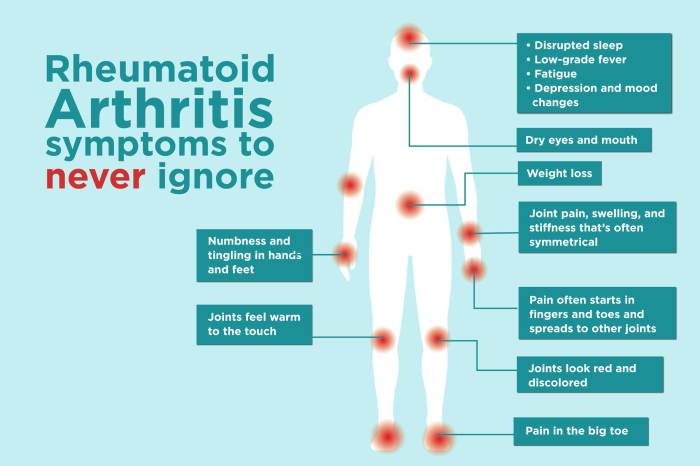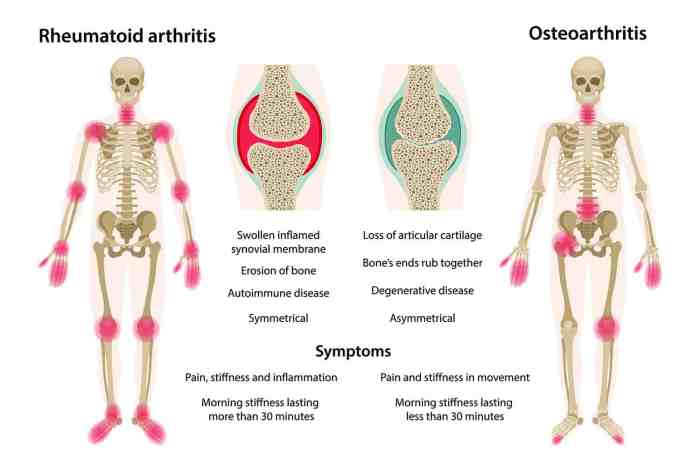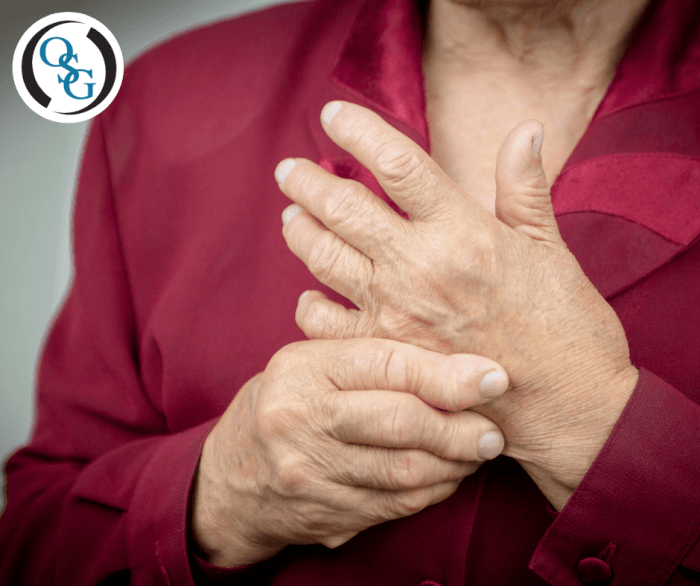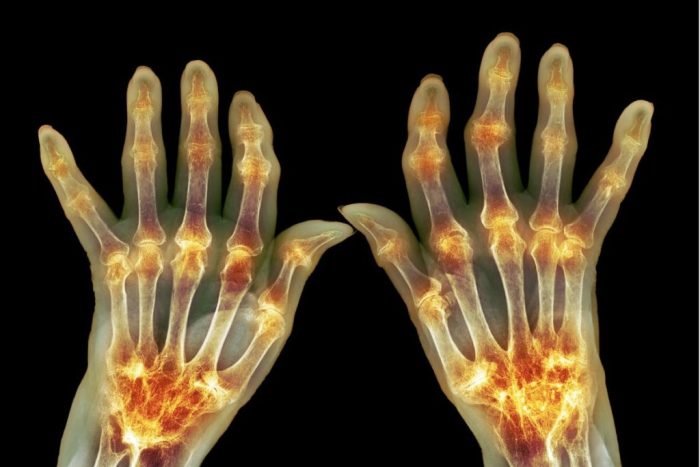Which statement is true regarding rheumatoid arthritis and osteoarthritis? Rheumatoid arthritis (RA) and osteoarthritis (OA) are two distinct types of arthritis that affect millions of people worldwide. While both conditions can cause joint pain and stiffness, they have different causes, symptoms, and treatments.
This article will explore the key differences between RA and OA, providing a comprehensive overview of these common conditions.
RA is an autoimmune disease that causes inflammation of the synovial membrane, the lining of the joints. This inflammation can lead to joint pain, swelling, and stiffness. RA can also affect other organs in the body, such as the heart, lungs, and eyes.
OA, on the other hand, is a degenerative disease that causes the cartilage in the joints to break down. This can lead to joint pain, stiffness, and crepitus (a grinding sensation). OA typically affects the weight-bearing joints, such as the knees, hips, and spine.
Overview of Rheumatoid Arthritis (RA) and Osteoarthritis (OA)

Rheumatoid arthritis (RA) and osteoarthritis (OA) are two distinct types of arthritis that affect millions of people worldwide. While they share some similarities, such as joint pain and stiffness, they have different causes, symptoms, and progression patterns.
RA is an autoimmune disease in which the body’s immune system mistakenly attacks the joints. This inflammation can lead to joint pain, swelling, and damage to the cartilage and bone. OA, on the other hand, is a degenerative joint disease that occurs when the protective cartilage that cushions the ends of bones wears down.
This can lead to pain, stiffness, and loss of function.
| Characteristic | RA | OA |
|---|---|---|
| Cause | Autoimmune disease | Degenerative disease |
| Most commonly affected joints | Small joints of the hands, feet, and wrists | Weight-bearing joints, such as the knees, hips, and spine |
| Symptoms | Joint pain, swelling, stiffness, and fatigue | Joint pain, stiffness, and crepitus |
| Progression | Can progress rapidly and lead to joint damage | Progresses slowly over time |
| Treatment | Medications, biologics, and physical therapy | Pain management, lifestyle modifications, and surgery in severe cases |
Pathophysiology of RA and OA

Rheumatoid Arthritis, Which statement is true regarding rheumatoid arthritis and osteoarthritis
RA is caused by an autoimmune response in which the body’s immune system attacks the synovial membrane, the lining of the joints. This inflammation can lead to the production of cytokines, which are proteins that promote inflammation and cartilage destruction.
Over time, the inflammation can damage the cartilage and bone, leading to joint pain, swelling, and deformity.
Osteoarthritis
OA is a degenerative disease that occurs when the cartilage that cushions the ends of bones wears down. This can happen due to age, obesity, or injury. As the cartilage wears down, the bones rub together, causing pain, stiffness, and crepitus (a grating sound).
OA can also lead to the formation of osteophytes, or bone spurs, which can further damage the joint.
Clinical Manifestations of RA and OA: Which Statement Is True Regarding Rheumatoid Arthritis And Osteoarthritis

Rheumatoid Arthritis, Which statement is true regarding rheumatoid arthritis and osteoarthritis
The most common symptoms of RA are joint pain, swelling, and stiffness. The pain is typically worse in the morning and improves throughout the day. RA can also affect extra-articular organs and systems, such as the skin, lungs, heart, and eyes.
Osteoarthritis
The most common symptoms of OA are joint pain, stiffness, and crepitus. The pain is typically worse with activity and improves with rest. OA can also lead to functional limitations and a decreased quality of life.
Diagnosis and Differential Diagnosis of RA and OA

The diagnosis of RA and OA is based on a combination of physical examination, medical history, and laboratory tests. Blood tests can help to identify inflammation and rule out other conditions. Imaging studies, such as X-rays and MRI scans, can help to visualize the joints and assess the extent of damage.
RA and OA can be difficult to differentiate from each other, as they share some similar symptoms. However, there are some key differences that can help to distinguish between the two conditions. For example, RA typically affects multiple joints, while OA usually affects only one or two joints.
RA also tends to cause more swelling and inflammation than OA.
Treatment Strategies for RA and OA
Rheumatoid Arthritis, Which statement is true regarding rheumatoid arthritis and osteoarthritis
The goal of RA treatment is to reduce inflammation, relieve pain, and prevent joint damage. Treatment options include medications, such as nonsteroidal anti-inflammatory drugs (NSAIDs), disease-modifying antirheumatic drugs (DMARDs), and biologics. Physical therapy can also help to improve joint function and range of motion.
Osteoarthritis
The goal of OA treatment is to relieve pain and improve function. Treatment options include pain management, lifestyle modifications, and surgery in severe cases. Pain management options include NSAIDs, opioids, and physical therapy. Lifestyle modifications, such as weight loss and exercise, can also help to reduce pain and improve function.
Prognosis and Outcomes of RA and OA
The prognosis of RA and OA depends on a number of factors, including the severity of the disease, the treatment plan, and the individual’s overall health. With early diagnosis and treatment, most people with RA can live a full and active life.
However, RA can be a debilitating disease, and some people may experience joint damage and disability.
OA is a progressive disease, and the symptoms will typically worsen over time. However, with proper treatment, most people with OA can manage their pain and maintain a good quality of life.
FAQ Corner
What is the difference between rheumatoid arthritis and osteoarthritis?
RA is an autoimmune disease that causes inflammation of the synovial membrane, while OA is a degenerative disease that causes the cartilage in the joints to break down.
What are the symptoms of rheumatoid arthritis?
The symptoms of RA can include joint pain, swelling, stiffness, fatigue, and weight loss.
What are the symptoms of osteoarthritis?
The symptoms of OA can include joint pain, stiffness, crepitus, and decreased range of motion.
How is rheumatoid arthritis treated?
RA is treated with a variety of medications, including disease-modifying antirheumatic drugs (DMARDs), biologics, and corticosteroids.
How is osteoarthritis treated?
OA is treated with a variety of medications, including pain relievers, anti-inflammatories, and physical therapy.